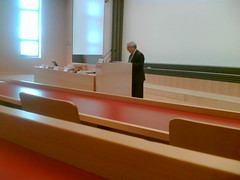| Some notes from "The Networked City: Information and communication technologies, spatial structure, and urban dynamics", a presentation by Manuel Castells at EPFL today. He addressed the transformation of urban/spatial forms due to IT and transportations systems. The presentations was in french, I took notes in english but it might be a bit rough. |  |
Networks are a fundamental transformation in the last 20 years, not due to technology, but intrinsically connected to it. If we say "network", we think globalization and no boundaries because they are organized around exchange that goes beyond institutions. These network have a specific dynamic: inclusion/exclusion.
Predictions done by "futurists" has proven to be wrong: the end of the city (due to IT transformations). We are seeing the most important urbanization phenomenon we have ever seen (50% of the earth population lives in cities today, 75% in 2050; Earth is not overpopulated, it's true for Belgium but not for Russia or Africa, 90% of california has village with less then 1000 inhabitants).
Analyzing the socio-spatial transformations due to IT, studies at his lab in UC Berkeley showed that there is no concentration and no decentralization: but there are both at the same time. This is a fundamental characteristics of networks: concentration and deconcentration. The point is to know what is concentrated and what is not (+ which sort of spatial constructions). They found a huge processus of concentration in metropolitan regions (more than areas), and inside there is a big decentralization of fonctions with polycentric structures. See "The polycentric metropolis": constitution of macro-regions in europe (Tokyo-Nagoya, Paris-Lilles-Bruxelles, Ruhr, North of Italy, Lyon-Grenoble-Torino, Greater Shangai, San Paolo, Buenos Aires, LA).
Articulation/Interconnections of those regions thanks to transport and communication technologies. Those mega-metropolis are articulated in world networks: the Global City (Saskia Sassen). BUT this does not mean that part of the region is global: some parts of NYC are absolutely local and not connected. It's rather that every city interconnected with other is a Global City. The different proportion of global/local in every city showed the level of dominance. There are different specificies of the network: finance (London, NYC), technology (Silicon Valley), criminal economy (5% of world GDP), Visitors' city: the city for tourists, which is not the real city (ramblas in Barcelona, old city centers in europe...) with different NODES in every city.
This is important for public policies: the point is to be involved in wealth creation networks and then local redistribution (but how? where?). This creates tensions, that urbanists and architects have to deal with. Wireless and mobile communication accentuates this phenomenon of concentration/deconcentration because it's not well distributed (even though 2Mb of mobile phones). Some strategies like people with bikes that can recharge their mobile phones in Africa. + Example of Bill Mitchell's new work (who created a new lab at MIT: MIT Design Lab): interconnections between built space and communication space.
People don't live in the space that we in europe call "los angeles" but they refer either to the part of the city leave in or a bigger dimension. So naming the metropolitan regions is very difficult: here we are Lausanne and not Geneva but for the rest of the world it's the french part of Switzerland. Normally, it's the means of communication that often gives the name to refer: in LA, it's the Southland (Santa Barbara to Tijuana), decentralization of economic structures, industries, social segregation (rich people who build their own ghetto). There are also different models related to the density: very dense areas allow to have more service and more opportunity for people to meet.
Castells underlined the 3 most important problems of those regions: - how to establish a multimodal communication system (it's not anymore public transport versus cars but cars, pedestrians, bikes, buses, electrical cars...); and it's not only transport but communication: how cell phones/smart information systems allows to organize these transports - how to preserve public space in which social life could be articulated: a need to prevent public space to be privatized (big shopping malls in the periphery of cities). - what about the institutional coordination at the metropolitan regions level: it does not exist and the solutions that exists so far did not work
Then he presented 3 different interventions/design solutions: - more planning of mobility and connectivity: usage of "ground" and multimodality must be better planned in order to less concentrate flow. - paying attention to environmental issues: some regions are close to ecological disasters (water, diseases, air quality...), not only in the Third World but also in LA - one of the most important problem is how to diffuse in the city the cultural sense of cities: there are more and more "villes sans histoires" (cities without history): less and less physical/cultural marks for inhabitants, less intermediary forms between their home and the world. An idea was to built monuments ("architecture de signature") a la Ghery, but it's still problematic and concentrated in specific places: it does not solve the loss of sense for daily life of inhabitants. Barcelona managed to have an innovative solution: opening public space with urban architecture (sculpture, small monuments...), people don't always like them but at least they make senses, as landmarks for navigation for instance.
He concluded that every attempt to articulate citizens needs in these metropolitan regions should start with the political will; and it does not exist: so it's rather a problem of reconstructing or tightening between professional of space (urban planners, architects...) and populations.
To read: "Mobile communication in Society", by Manuel Castells (MIT Press), November 2006